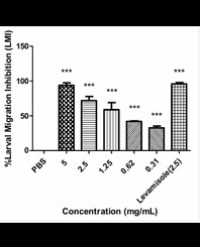
In vitro Anthelmintic Activity of Euphorbia hirta L Aqueous Extracts on Small Ruminant’s Gastrointestinal Parasites Evaluation
Purpose: With the aim of proposing an effective and accessible alternative for small ruminant gastrointestinal parasitosis control, the in vitro anthelmintic activity of Euphorbia hirta on Haemonchus contortus biology was evaluated.
Methods: Aqueous extracts were used to determine phytochemistry and for the biological tests of adult worm mortality as well as egg hatching and L3 larval migration inhibition. Aqueous extract concentrations of 6.25, 12.5, 25, 50 and 100 mg/mL were used for the adult worm mortality test, while concentrations of 0.31, 0.62, 1.25, 2.5 and 5 mg/mL were used for the egg hatching and L3 larval migration inhibition tests.
Results: The results show a total polyphenol content of 17.5 mgEAG/100 mg, total flavonoids of 0.24 mgEQ/100 mg and condensed tannins of 0.17 mgEAT/100 mg. Adult worm mortality was concentration dependent, reaching 100% at 50 and 100 mg/mL concentrations, from the sixth hour, with a lethal concentration 50 (LC50 ) of 21.09 mg/mL. The 50% inhibitory concentration of egg hatching (IC50 ) was 1.7 mg/mL, while the IC50 of larval migration recorded was 0.78 mg/mL.
Conclusion: In view of the results obtained, the in vitro anthelminthic activity of the aqueous extract of E hirta was confirmed. However, further biological studies will be needed to validate these results, with a view to their wider use.
Amadou Dicko1*, Almamy Konaté1, Sami Eric Kam3, Hadidjatou Belem3, Basile Tindano2, Abdoul Aziz Almoustapha Cissé5, Gaoussou Keïta4, Roland Nâg-Tiéro Meda3, Adama Kaboré1, Amadou Traoré1, Balé Bayala2 and Hamidou Hamadou Tamboura1


